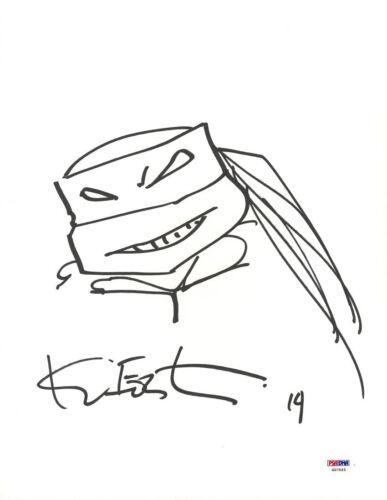Kevin Eastman Biography
Kevin Eastman is an American comic book artist and writer best known for co-creating Teenage Mutant Ninja Turtles with Peter Laird. Eastman is also the editor and publisher of the magazine Heavy Metal.
Kevin Eastman Age
Kevin was born on May 30, 1962, in Portland, Maine, United States. He is aged 60 years as of 2022.
Kevin Eastman Height
He stands at a height is 2.0 m tall, and his weight is 70 kg.
Kevin Eastman Family
Eastman was born in Portland, Maine, United States to his parents, his mother worked as a phlebotomist and his father made tools. He was mainly raised by his grandmother after his parents split up. His grandmother was a painter which is where Eastman got his inspiration from.
Kevin Eastman Wife and Personal Life
He was previously married to Julie Strain from 1997 – 2008. He and his wife live in San Diego with their son Shane and pet dachshunds. He has acted in a small number of films, including Guns of El Chupacabra in 1997 and The Rock n’ Roll Cops in 2003. He also had a supporting role in the 2004 Troma film Tales from the Crapper. Prior to that, he had a cameo in the 2000 sequel to The Toxic Avenger called Citizen Toxie: The Toxic Avenger IV.
He had a small role in the first TMNT movie as a garbage collector. From his Facebook page, Kevin spends most of his creative time working on a new TMNT series with IDW Publishing and editing Heavy Metal. Eastman partnered with writer, director, and producer Robert Rodriguez to develop a new series of Heavy Metal-inspired animated and live-action films.

Kevin Eastman Net Worth
The American comic book artist and writer has a net worth of $20 million.
Kevin Eastman Salary
Eastman earns an estimated salary of about $10000 to $50000 annually.
Kevin Eastman Education
Eastman was born in Portland, Maine. The writer attended Westbrook High School in Westbrook, Maine, with comic book illustrator Steve Lavigne. He was “raised in a Christian family.” He worked in a restaurant while he searched for publishers for his comics in 1983. He met a waitress who was attending the University of Massachusetts Amherst and followed her to Northampton, Massachusetts.
When searching for a local underground newspaper to publish his work, he began a professional relationship with Peter Laird, and the two collaborated for a short time on various comics projects. Eastman and Laird self-published the first black & white issue of Teenage Mutant Ninja Turtles in May 1984. The forty-page oversized comic had an initial print run of 3,275 copies and was largely funded by a US$1000 loan from Eastman’s uncle Quentin.
It was published by the duo’s Mirage Studios, a name chosen because, as Eastman says, “there wasn’t an actual studio, only kitchen tables and couches with lapboards.” By September 1985, their first issue had received three additional printings.
Kevin Eastman Career
Teenage Mutant Ninja Turtles
Main articles: Teenage Mutant Ninja Turtles and Teenage Mutant Ninja Turtles (Mirage Studios)
Laird’s newspaper experience led to the two creating a four-page press kit, which included a story outline and artwork. They sent the press kit to 180 television and radio stations as well as to the Associated Press and United Press International. This led to widespread press coverage of both the Teenage Mutant Ninja Turtles and Mirage Studios itself, creating a demand for the comic.
With their second issue, Eastman and Laird’s Turtles comic began a quick rise to success, bringing in advance orders of 15,000 copies, five times the initial print run of the first issue. It earned him and Laird a profit of $2,000 each and allowed them to become full-time comic book creators. Turtles phenomenon saw the duo invited to their first comics convention at the tenth annual Atlanta Fantasy Fair in 1984, where they mingled with notable comic creators like Larry Niven, Forrest J Ackerman, and Fred Hembeck.
Licensing
The Mirage Turtles comic led to a widening media presence for the heroes. He and Laird began to widely merchandise their property. Dark Horse Miniatures produced a set of 15 lead figurines for role-playing gamers and collectors, Palladium Books produced a role-playing game featuring the Turtles, and First Comics reprinted in four volumes the first eleven issues as color trade paperback collections.
Palladium’s role-playing game brought the Turtles to the attention of licensing agent Mark Freedman and the Turtles phenomenon took off, with the various characters soon appearing on T-shirts, Halloween masks, mugs, and other paraphernalia. The five-part televised cartoon mini-series based on the Turtles debuted in December 1987. Half-hour episodes were produced by Osamu Yoshioka and the animation was directed by Yoshikatsu Kasai from scripts David Wise and Patti Howeth.
Mini-series was successful, leading to a full series, with the mini-series forming the first season. The series had a 9-year, 10-season, 193-episode run.
Multimedia
Other multiple Turtles comics, toys, books, games, and other merchandising items have subsequently appeared, overseen, and sometimes fully created by Eastman and Laird. Among these are five live-action films: Teenage Mutant Ninja Turtles (1990), Teenage Mutant Ninja Turtles II: The Secret of the Ooze (1991), Teenage Mutant Ninja Turtles III (1993), Teenage Mutant Ninja Turtles (2014), and Teenage Mutant Ninja Turtles: Out of the Shadows (2016), with Eastman making a brief cameo in the latter.
Four more television series were also created: Ninja Turtles: The Next Mutation (1997), Teenage Mutant Ninja Turtles (2003), Teenage Mutant Ninja Turtles (2012), in which Eastman wrote the fifth season episode “Lone Rat and Cubs”, and Rise of the Teenage Mutant Ninja Turtles. Later there was also an animated feature film, TMNT (2007).
Eastman & Laird: Parting ways
Later creative differences began to strain Eastman and Laird’s partnership. In an interview in 2002, Laird noted that the two hadn’t spent much time together since 1993. Eastman moved to California while Laird stayed in Massachusetts. On June 1, 2000, Laird and the Mirage Group purchased Eastman’s ownership in the Teenage Mutant Ninja Turtles property and corporations.
Eastman wanted to move on to other projects. The buyout was completed on March 1, 2008. Eastman in 2011, began working with the TMNT series again as a writer and artist on the IDW comic series, as well as an adviser on the 2014 reboot of the Teenage Mutant Ninja Turtles film series. He is said to have a cameo in the film as a doctor and has voiced the character Ice Cream Kitty in the 2012 CGI series.
Tundra
Main article: Tundra Publishing
Foundation
When co-managing Mirage Studios, Eastman and Laird often spoke of the difficulties in maintaining creative control of their work. He decided to address this problem by using his own personal knowledge and connections to help other creators.
Intentions and output
He founded Tundra Publishing in 1990, to realize personal and other projects. He joined with other comic creators like Scott McCloud and Dave Sim to form the Creator’s Bill of Rights. He felt obligated to expand it beyond theory and into practice, providing a forum for comics creators to work for a publisher while maintaining ownership of their work.
Projects (partly) realized by Tundra included: Alan Moore and Bill Sienkiewicz’s Big Numbers, Moore & Eddie Campbell’s From Hell, Moore & Melinda Gebbie’s Lost Girls (these last two original serialised in Stephen R. Bissette’s Taboo anthology, which was also part-published by Tundra), The Crow, Mike Allred’s Madman and Dave McKean’s Cages, and others.
He initially thought that his experience at Mirage gave him “a pretty good grasp of what a publisher should be, and what a publisher needs to do,” although he fast realized that “Tundra was not like publishing the Turtles.”
Difficulties
As part of Eastman’s designs for Tundra were to produce personal projects of a more adult nature than the Turtles-oriented Mirage was geared towards, this saw Tundra fitting in the dubious middle-ground, as their intended product sat somewhat awkwardly between the comic shop and the book shop. Eastman says that he “thought that the audience was a lot larger than it actually was,” citing his personal assumption that readers would “grow up through X-Men and discover The Sandman and then Dark Knight and Watchmen and beyond.”
The relatively new in-roads of comics and graphic novels into bookshops worked against Tundra at the time. He swiftly became aware that Tundra and the Turtles differed considerably, not least since the latter was successful enough to effectively run itself, with a few ‘nudges’ “to keep it moving along.” Tundra, on the other hand, dealt in new properties, which required “building from the ground up,” and was “a lot more work” than Eastman had anticipated, growing far too quickly for comfort, and requiring considerable injections of time and money, rather than being profitable.
Speaking in 1992/93, Eastman was optimistic that the company had “finally reached the point where [it had] slowed up enough… to be giving individual projects the time and attention they require[d];” Shortly thereafter, Tundra was bought out by Kitchen Sink Press, closing its (solo) doors after just three years, losing Eastman between $9 and $14 million.
Aftermath
Apart from heavy financial losses, Eastman remains philosophical about his work with Tundra, drawing the analogy that: making the Turtles was like going to college and doing Tundra Publishing was like getting my Master’s degree. So I learned a lot with the Turtles and I learned the rest of what I needed to know.. when I did Tundra.
Eastman makes mention of the multiple award nominations Tundra received during its first and second years, including Harvey Awards and Eisner Awards, but notes that despite critical acclaim, the company was not making money on its titles, and had to cease production. Eastman notes that Tundra was one of the earlier creator-owned companies, “before Image really took off” and before Dark Horse Comics’ “Legends line.”
Eastman admits that Tundra tried to do too much too quickly, and ran into difficulties accordingly. He suggests that “[n]ot one book made any money”. He also believes that part of Tundra’s downfall was tied to his offering Marvel and DC employees the chance to work on creator-owned and personal projects.
Kevin Eastman Art
Main article: Words & Pictures Museum
He purchased his first piece of original artwork (“a couple of pages that were penciled by Michael Golden and inked by Bob McLeod for Marvel Comics’ Howard the Duck”) in Atlanta Fantasy Fair, the convention he and Laird attended in 1984. Collecting subsequently became “quite an addiction” for him, and combined with his experiences in getting his, and others’, comics work recognised as “Art,” led to him founding the Words & Pictures Museum, which operated as a brick-and-mortar museum from 1992–1999.
Kevin Eastman Books
Apart from his work on multiple Teenage Mutant Ninja Turtles projects, and as publisher of Tundra Publishing, Eastman has created a variety of other comics work. One of these projects was Fistful of Blood, a black and white graphic novel featuring a blend of influences from spaghetti western and horror. The book featured art by Simon Bisley and was published by Heavy Metal.
He is an interviewee in the documentary movies Independents and Turtle Power: The Definitive History of the Teenage Mutant Ninja Turtles.
Kevin Eastman Signature
